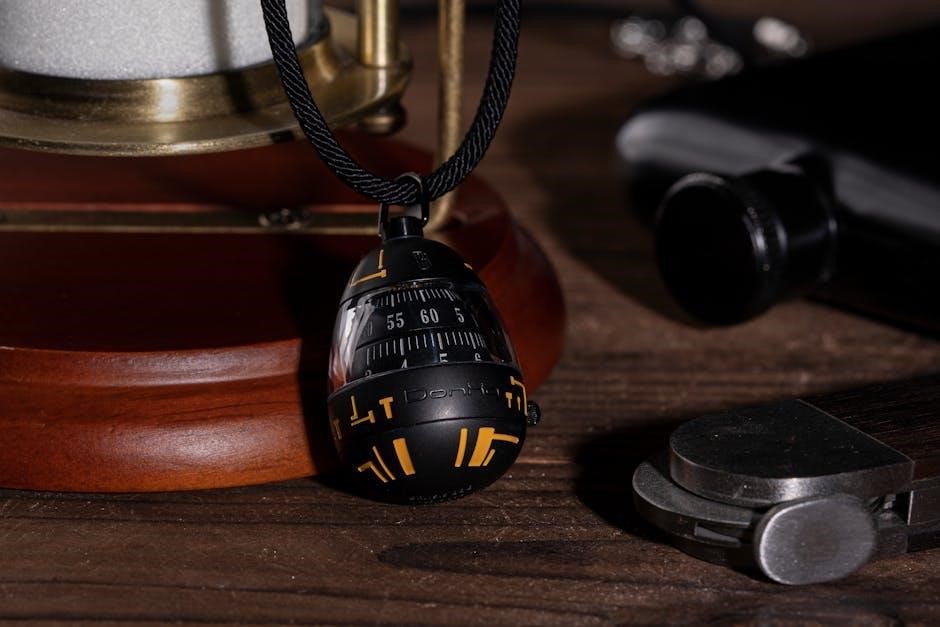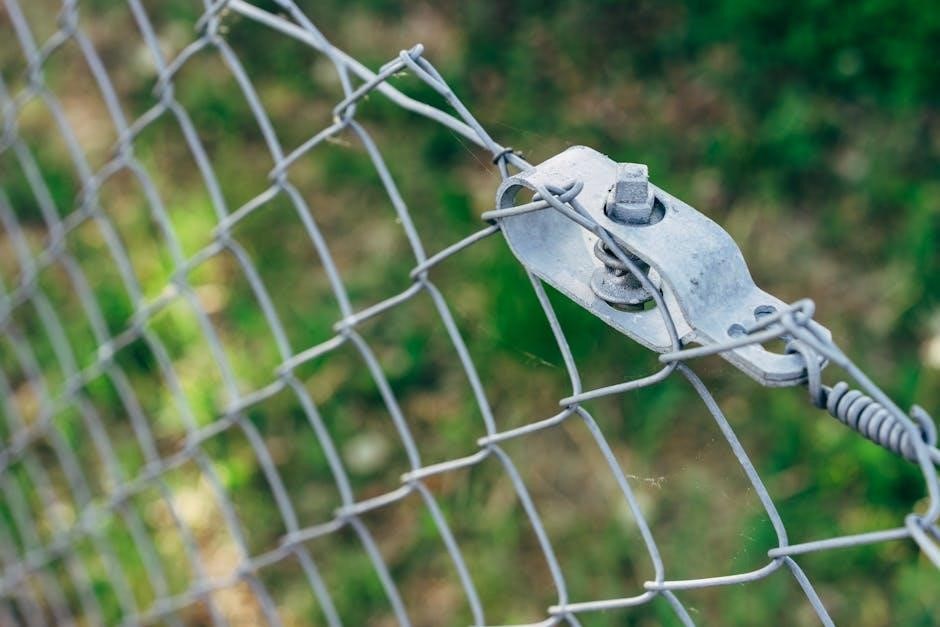The 2.4 Ecotec timing chain system is a critical component of the engine‚ ensuring synchronized rotation of camshaft and crankshaft. It includes guides‚ tensioners‚ and bolts.
1.1 Overview of the 2.4 Ecotec Engine Timing Chain Components
The 2.4 Ecotec engine timing chain system consists of several key components‚ including the timing chain‚ guides‚ tensioners‚ and bolts. The timing chain itself drives the camshaft‚ ensuring synchronization with the crankshaft. Guides are designed to keep the chain aligned and prevent it from jumping teeth. Tensioners maintain proper chain tightness‚ while bolts secure the guides in place. These components work together to ensure precise engine timing and smooth operation. The guide bolts‚ in particular‚ play a critical role in maintaining the structural integrity of the timing chain system. Any failure in these components can lead to misalignment‚ noise‚ or even engine damage. Regular inspection and maintenance are essential to prevent issues.
1.2 Importance of Timing Chain Guide Bolts in Engine Operation
Timing chain guide bolts are essential for securing the timing chain guides in place‚ ensuring proper alignment and tension. They prevent the chain from misaligning‚ which could cause engine misfires or damage. These bolts also withstand significant stress from the engine’s operation‚ making their integrity crucial. Failure of even one bolt can lead to a chain reaction of issues‚ including rattling noises‚ loss of power‚ and costly repairs. Their role is vital for maintaining the overall health and performance of the 2.4 Ecotec engine‚ emphasizing the need for regular inspections and prompt replacements if any wear is detected. Properly functioning guide bolts ensure smooth engine operation and prevent premature wear on other timing chain components.

Causes of Timing Chain Guide Bolt Failure
Timing chain guide bolt failure often stems from manufacturing defects‚ overloading‚ and chain stretching. These issues can weaken the bolts‚ leading to breakage under engine stress.
2.1 Manufacturing Defects in OEM Bolts
Manufacturing defects in OEM bolts are a common cause of failure. Some bolts may have inadequate thread quality or insufficient tensile strength‚ making them prone to snapping. Over time‚ these defects can lead to unexpected breakage‚ especially under the constant stress of engine operation. Replacing faulty OEM bolts with high-strength aftermarket alternatives‚ such as those made by Dorman‚ can provide a more reliable solution and prevent future issues. Regular inspections and maintenance are crucial to identify and address these defects before they cause catastrophic engine damage.
2.2 Overloading and Stress on the Timing Chain System
Overloading and excessive stress on the timing chain system can lead to premature wear and failure of guide bolts. Aggressive driving‚ towing heavy loads‚ or frequent engine strain increases tension on the chain. This added stress can cause the bolts to weaken over time‚ especially if they are already compromised by manufacturing defects. Engine misfires‚ irregular combustion‚ or sudden acceleration can further exacerbate the issue. If left unchecked‚ chronic overloading may result in bolt failure‚ disrupting the timing chain’s alignment and potentially causing costly engine damage. Regular maintenance and avoiding excessive strain are critical to preventing such issues.
2.3 Stretching or Wearing of the Timing Chain
Stretching or wearing of the timing chain is a common issue in the 2.4 Ecotec engine. Over time‚ the chain can elongate due to heat‚ friction‚ and repeated stress‚ leading to improper tension. This wear causes the chain to slip or rattle‚ placing additional strain on the guide bolts. If the chain stretches beyond its tolerance‚ it can misalign the camshaft and crankshaft‚ resulting in poor engine performance. In severe cases‚ a stretched chain may cause the bolts to fail‚ as they cannot maintain proper alignment or tension. Regular inspections and replacing the chain when signs of wear appear are essential to prevent bolt failure and maintain engine reliability.

Symptoms of a Broken Timing Chain Guide Bolt
Unusual engine noises‚ such as rattling or clunking sounds‚ often indicate a broken timing chain guide bolt. The check engine light may illuminate‚ and error codes like P0016 can appear‚ signaling misfires or improper timing. Additionally‚ a loss of engine power or rough idling may occur due to the chain misalignment caused by the bolt failure.
Unusual engine noises‚ such as rattling or clunking sounds‚ are common indicators of a broken timing chain guide bolt. These noises typically arise from the chain slapping against engine components or the guide moving out of place. The sounds may be more pronounced during acceleration or when the engine is under load. If left unaddressed‚ the noise can escalate‚ leading to further damage to the timing chain system. Immediate attention is crucial to prevent costly repairs. The illumination of the check engine light is a clear sign of a problem within the engine‚ often related to the timing chain system. When a timing chain guide bolt fails‚ it can disrupt the proper operation of the chain‚ leading to misfires or uneven engine performance. Modern engines are equipped with sensors that detect such issues‚ triggering the check engine light. Codes such as P0016‚ related to camshaft and crankshaft position correlation‚ may appear‚ indicating timing chain problems. Ignoring this warning can lead to further damage‚ making it essential to address the issue promptly. Always use an OBD-II scanner to identify the specific fault. A broken timing chain guide bolt can lead to a loss of engine power or misfires‚ as the timing chain may slip or jump‚ disrupting the engine’s precise timing. This misalignment causes cylinders to fire incorrectly‚ reducing power and efficiency. Drivers may notice hesitation‚ rough idling‚ or a decrease in performance‚ especially under load. Error codes such as P0016 or P0017 often accompany these symptoms‚ indicating a timing-related issue. If left unrepaired‚ the problem can escalate‚ causing further damage to the engine. Addressing the issue promptly is crucial to preventing costly repairs and ensuring the engine runs smoothly. Regular inspections can help identify potential failures before they lead to power loss or misfires. Error codes like P0016 and P0017 are commonly associated with timing chain issues in the 2.4 Ecotec engine. These codes indicate a misalignment between the camshaft and crankshaft‚ often caused by a broken timing chain guide bolt or a stretched chain. When the timing chain system fails‚ the engine’s computer detects the timing mismatch and logs these codes. Drivers may notice the Check Engine Light illuminating‚ along with symptoms like misfires or reduced power. Scanning the OBD-II system will reveal these codes‚ guiding mechanics to inspect the timing chain and related components. Addressing these issues promptly is essential to prevent further engine damage and restore proper operation. Diagnosing timing chain guide bolt issues involves visual inspections‚ scanning for OBD-II codes‚ and checking chain tension and alignment. Early detection prevents engine damage. A thorough visual inspection is essential to identify issues with the timing chain and guides. Mechanics should look for signs of wear‚ such as frayed edges or misalignment. Scanning for OBD-II codes is a crucial step in diagnosing timing chain issues. Codes like P0016 indicate misalignment between the camshaft and crankshaft. This helps pinpoint problems early. Checking the timing chain tension and guide alignment is essential for diagnosing issues. A slack chain or misaligned guides can lead to premature wear or failure. Inspect the chain visually for excessive play or uneven movement. Use a torque wrench to ensure proper tension‚ as specified in the manufacturer’s guidelines. Misalignment can cause unusual engine noises or performance issues. Verify that all guides are securely fastened and properly aligned with the chain. If the chain is loose or the guides are worn‚ it may indicate a need for replacement. Proper alignment ensures smooth engine operation and prevents further damage to the timing chain system. This step is critical for maintaining engine reliability. The repair involves removing the broken bolt‚ inspecting the guide‚ and installing a new bolt. Special tools may be required for proper torque and alignment. To replace the timing chain guide bolts‚ you’ll need a 3/8″ and 1/4″ torque wrench for precise bolt tightening. Additional tools include a socket set‚ wrenches‚ and a drain pan for oil. Specialized equipment like a timing chain tensioner tool may also be necessary to ensure proper alignment and tension. It’s important to use high-quality tools to avoid stripping bolts or causing further damage. Having a repair manual or access to online guides can provide step-by-step instructions and torque specifications. Always ensure the tools are in good condition to complete the job effectively and safely. Begin by loosening the broken bolt using a wrench‚ then remove it completely. If the bolt is seized or damaged‚ penetrating oil may help. Once the bolt is out‚ carefully pull the guide away from the engine. Inspect the area for any remaining debris or fragments. If the guide is broken‚ gently pry it out‚ taking care not to damage surrounding components. Clean the mounting surface to ensure proper installation of the new bolt and guide. This process can often be done with the engine still in the car‚ but access may vary depending on the vehicle model. Insert the new bolt into the guide hole‚ ensuring it’s properly seated. Tighten the bolt using a torque wrench to the specified torque value. Next‚ align the timing chain with the crankshaft and camshaft marks‚ ensuring proper synchronization. Gently pull the chain taut and check its tension. Once aligned‚ secure the guide in place. Start the engine and listen for unusual noises to confirm proper installation. This process can often be done with the engine in the car‚ allowing easier access to other components if needed. The Dorman bolt is a popular upgrade‚ offering increased strength and reliability compared to the stock bolt. When installing the new timing chain guide bolt‚ ensure the torque specifications are followed precisely. Typically‚ the bolt requires a torque of 35-40 ft-lbs in two stages: first‚ tighten to 20 ft-lbs‚ then angle tighten an additional 75-90 degrees. Use a torque wrench to achieve accurate measurements. Over-tightening can damage the engine block or strip threads‚ while under-tightening may lead to bolt loosening. Refer to the manufacturer’s guidelines for exact specifications. Proper torque ensures the timing chain remains secure and aligned‚ preventing future issues. Always double-check the torque after tightening to confirm it meets the required standards. Replacement costs vary‚ with OEM bolts priced higher than aftermarket options. Labor fees range from $200 to $500‚ while DIY kits can save significantly on labor expenses. OEM timing chain guide bolts are typically more expensive than aftermarket alternatives‚ often costing between $50 to $100 per bolt. Aftermarket options‚ such as Dorman bolts‚ are priced lower‚ around $30 to $70‚ offering similar quality and durability. While OEM parts are guaranteed to meet factory specifications‚ aftermarket bolts like Dorman are known for being stronger and more reliable‚ making them a popular choice among mechanics and DIYers. The cost difference can be significant when replacing multiple components‚ making aftermarket parts a cost-effective solution for many vehicle owners. Labor costs for replacing timing chain guide bolts in a 2.4 Ecotec engine can range from $300 to $700‚ depending on the mechanic’s expertise and location. Dealerships often charge higher rates‚ up to $900 for labor alone‚ while independent shops may offer more competitive pricing. If additional repairs‚ such as replacing the entire timing chain or tensioners‚ are required‚ labor costs can increase significantly. In some cases‚ a full timing chain job‚ including parts and labor‚ can cost around $1‚400‚ as seen in quotes from specialists in the Chicagoland area. While labor is a major expense‚ it ensures the repair is done correctly and efficiently. DIY repair for 2.4 Ecotec timing chain guide bolts can save significant costs compared to professional labor. Parts‚ including high-strength bolts like the Dorman option‚ typically range from $50 to $200. Tools such as a 3/8 torque wrench and basic engine tools are often already owned or inexpensive. By tackling the job yourself‚ you can avoid labor fees that range from $300 to $700‚ resulting in substantial savings. Additionally‚ addressing related issues like chain tension or guide alignment during the repair can prevent future breakdowns‚ further reducing long-term costs. DIY repairs require mechanical skills but offer a cost-effective solution for budget-conscious owners. Regular inspections and maintaining proper engine lubrication help prevent timing chain guide bolt failures. Upgrading to high-strength bolts and monitoring chain tension can ensure long-term reliability and performance. Regular maintenance is essential to prevent timing chain guide bolt failures. Inspecting the chain‚ guides‚ and tensioners at recommended intervals ensures early detection of wear or misalignment. Lubrication checks and replacing worn components promptly can prevent catastrophic damage. Monitoring engine performance and addressing unusual noises or illuminated check engine lights immediately helps avoid costly repairs. Routine inspections by a qualified mechanic can identify potential issues before they escalate‚ ensuring the longevity and reliability of the 2.4 Ecotec engine. Proactive care significantly reduces the risk of bolt failure‚ maintaining engine efficiency and performance over time. Upgrading to high-strength bolts is a proactive measure to enhance the durability of the timing chain system. Aftermarket options‚ such as Dorman bolts‚ are designed with superior materials and thread patterns‚ reducing the risk of failure. These bolts are often made from aerospace-grade steel‚ providing increased tensile strength compared to OEM parts. Upgrading prevents future issues like bolt snapping or guide misalignment‚ which can lead to costly repairs. Proper installation‚ including correct torque specifications‚ is crucial to ensure reliability. This upgrade not only extends engine life but also provides peace of mind for drivers‚ especially in high-mileage vehicles. It’s a recommended step for owners seeking long-term performance and durability. Monitoring engine performance and listening for unusual sounds is crucial for early detection of timing chain issues. Rattling or clunking noises‚ often heard during cold starts or acceleration‚ can indicate worn guides or loose bolts. Regular checks for misfires or reduced power help identify problems before they escalate. Using OBD-II scanners to monitor engine codes‚ such as P0016‚ ensures timely intervention. Drivers should also be vigilant about changes in engine behavior‚ as silent failures can lead to sudden breakdowns. Consistent monitoring allows for proactive maintenance‚ preventing catastrophic damage and costly repairs. This practice is especially vital for high-mileage vehicles or those with a history of timing chain issues. Common mistakes include incorrect torque application‚ misaligning the timing chain‚ and using substandard replacement parts‚ which can lead to further engine damage or premature failure. Incorrect torque application is a common mistake during timing chain guide bolt repair. Over-tightening or under-tightening can lead to stripped threads‚ bolt failure‚ or improper alignment. Always use a torque wrench and follow manufacturer specifications. For the 2.4 Ecotec engine‚ the torque for guide bolts typically ranges between 30-40 ft-lbs. Over-tightening can damage the engine block or bolt holes‚ while under-tightening may result in loose bolts that cause chain misalignment. This can lead to engine damage‚ misfires‚ or even complete timing chain failure. Proper torque application ensures the timing chain system operates smoothly and prevents costly repairs. Refer to the repair manual for exact torque specifications. Misalignment of the timing chain is a critical error during repair. If the chain is not properly aligned with the crankshaft and camshaft‚ it can lead to engine performance issues. This includes misfires‚ reduced power‚ and potential engine damage. Proper alignment ensures the chain runs smoothly over the gears and guides‚ maintaining correct timing. Misalignment can occur if the chain is installed incorrectly or if the guides are not securely fastened. Always use alignment marks on the gears and chain to ensure accuracy. Failure to correct misalignment can result in premature wear on components or complete system failure‚ necessitating costly repairs. Pay close attention to the chain’s position during installation to avoid this common mistake. Using substandard replacement parts can compromise the integrity of the timing chain system. Cheap or low-quality bolts and guides may fail prematurely‚ leading to costly repairs. These parts often lack the durability and precision of OEM components‚ increasing the risk of chain misalignment and engine damage. For instance‚ bolts with inferior thread quality or weaker materials can strip or break under stress. Similarly‚ substandard guides may not maintain proper chain tension‚ leading to noise and wear. Always opt for high-strength‚ OEM-recommended parts to ensure reliability and longevity. The Dorman bolt‚ mentioned in forums‚ is a stronger alternative to stock bolts‚ offering better durability and resistance to failure. Prioritizing quality parts is essential for maintaining engine performance and preventing future issues. This ensures the timing chain system operates efficiently and reliably over time. Avoiding substandard parts is a crucial step in a successful repair. GM may cover timing chain-related repairs under warranty for certain model years. Recalls specific to the 2.4 Ecotec engine have addressed chain tensioner and guide bolt issues. GM typically covers timing chain repairs under warranty for vehicles within the specified mileage and age limits. This coverage often extends to components like guide bolts and tensioners‚ addressing manufacturing defects or premature wear. Owners should consult their vehicle’s warranty documentation or contact GM directly to confirm coverage eligibility for their specific situation. GM has issued recalls for the 2.4 Ecotec engine‚ primarily addressing timing chain-related issues; These recalls often cover faulty components such as guide bolts‚ tensioners‚ and chains that may fail prematurely. Affected vehicles are typically notified‚ and repairs are conducted free of charge at authorized dealerships. It’s crucial for owners to check their VIN against recall databases to ensure compliance and prevent potential engine damage. Regular updates from GM ensure customer safety and maintain engine reliability. Regular maintenance‚ using high-quality parts‚ and professional assistance when needed are essential for preventing timing chain guide bolt failures. Monitoring engine performance helps ensure long-term reliability. The 2.4 Ecotec timing chain system is crucial for engine operation‚ with guide bolts playing a vital role in maintaining timing chain stability. Failures often stem from manufacturing defects‚ overloading‚ or chain wear‚ leading to symptoms like unusual noises‚ check engine lights‚ and power loss. Diagnosis involves visual inspections‚ OBD-II scanning‚ and tension checks. Repairs require precise tools and torque specifications‚ with options for OEM or aftermarket parts. Costs vary between DIY and professional services. Preventative measures include regular maintenance and upgrading to high-strength bolts. Common mistakes‚ such as incorrect torque application‚ misalignment‚ or using substandard parts‚ should be avoided. Proper care ensures long-term engine reliability and performance. Regular inspections of the timing chain system are essential to prevent bolt failures. Owners should monitor engine performance and address unusual noises promptly. Investing in high-strength bolts‚ such as those offered by Dorman‚ can enhance durability. Proper torque application during repairs is critical to avoid misalignment or premature wear. DIY enthusiasts should ensure they have the correct tools‚ including a torque wrench‚ before attempting repairs. Professional assistance is recommended for complex issues to prevent further damage. Maintaining the overall health of the engine through routine maintenance can significantly reduce the risk of timing chain guide bolt failures and ensure long-term reliability.3.1 Unusual Engine Noises (Rattling or Clunking Sounds)
3.2 Illumination of the Check Engine Light
3.3 Loss of Engine Power or Misfires
3.4 Error Codes Related to Timing Chain Issues (e.g.‚ P0016)

Diagnosis of Timing Chain Guide Bolt Issues
4.1 Visual Inspection of the Timing Chain and Guides
4.2 Scanning for OBD-II Codes
4.3 Checking for Chain Tension and Guide Alignment

Repair and Replacement of Timing Chain Guide Bolts
5.1 Tools and Equipment Required for the Job
5.2 Steps to Remove the Broken Bolt and Guide
5.3 Installing the New Bolt and Aligning the Timing Chain
5.4 Tightening Torque Specifications

Cost Analysis for Timing Chain Guide Bolt Replacement
6.1 OEM vs. Aftermarket Parts Pricing

6.2 Labor Costs for Professional Mechanics
6.3 DIY Repair Costs and Savings

Prevention of Future Timing Chain Guide Bolt Failures
7.1 Regular Maintenance and Inspections
7.2 Upgrading to High-Strength Bolts
7.3 Monitoring Engine Performance and Sounds

Common Mistakes to Avoid During Repair
8.1 Incorrect Torque Application
8.2 Misalignment of the Timing Chain
8.3 Using Substandard Replacement Parts

Warranty and Manufacturer Recall Information
9.1 GM Warranty Coverage for Timing Chain Issues
9.2 Recalls Related to the 2.4 Ecotec Engine
10.1 Summary of Key Points
10.2 Final Recommendations for Engine Owners